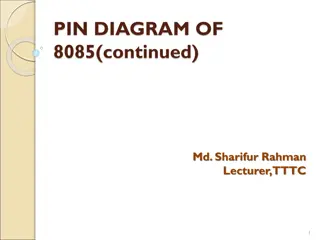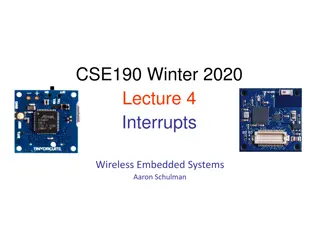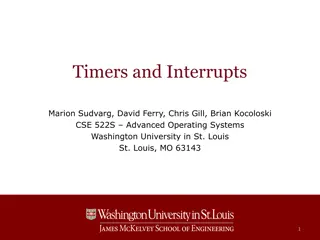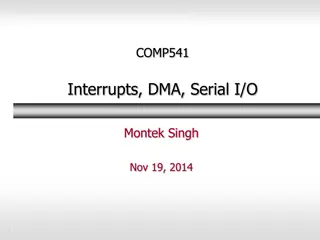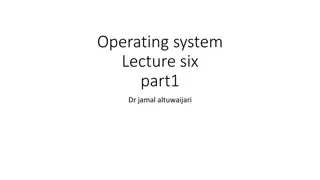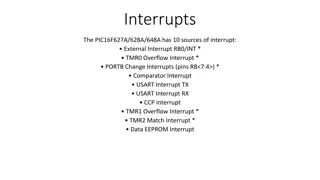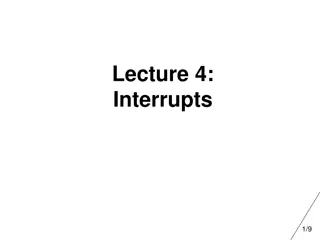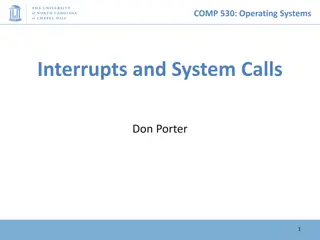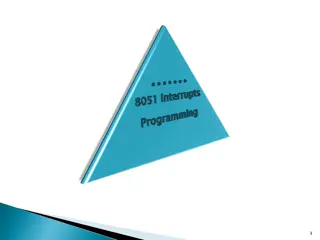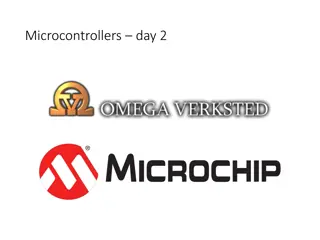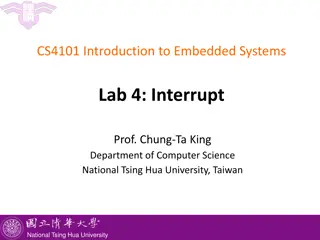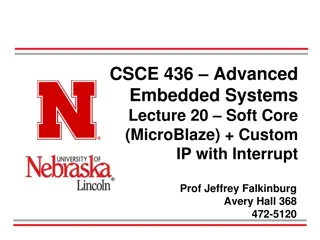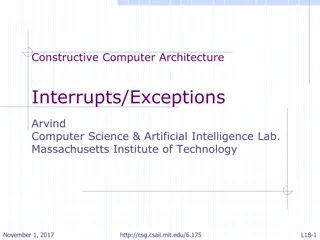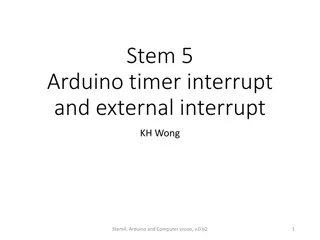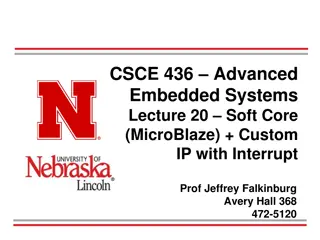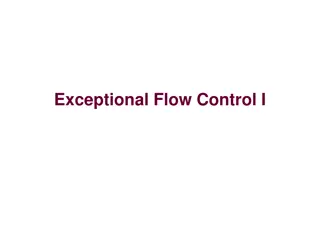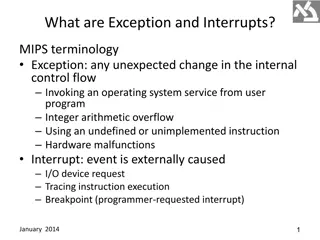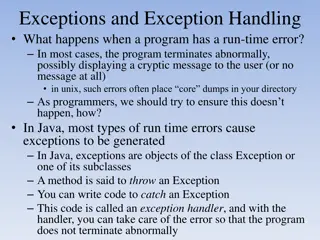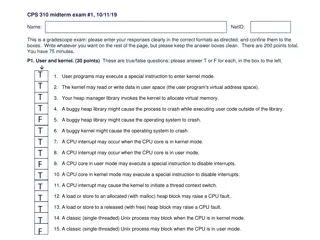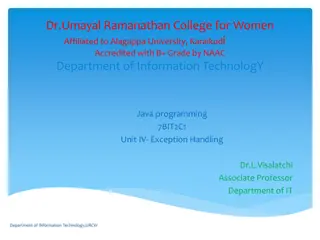Understanding Processor Interrupts and Exception Handling in Zynq Systems
Learn about interrupts, exceptions, and their handling in Zynq Systems. Explore concepts like interrupt sources, Cortex-A9 processor interrupts, interrupt terminology, and the difference between pooling and hardware interrupts. Gain insights into interrupt service routines, interrupt pins, interrupt priority, and NMI. Understand interrupt latency and response time for efficient system performance.
Download Presentation

Please find below an Image/Link to download the presentation.
The content on the website is provided AS IS for your information and personal use only. It may not be sold, licensed, or shared on other websites without obtaining consent from the author. Download presentation by click this link. If you encounter any issues during the download, it is possible that the publisher has removed the file from their server.
E N D
Presentation Transcript
Interrupts in Interrupts in Zynq ZynqSystems Systems C Cristian ristian S Sisterna isterna Universidad Nacional de San Juan Argentina
Exception / Interrupt Exception / Interrupt Special condition that requires a processor's immediate attention Exception Abnormal internal event (division by zero, illegal instruction) Software Interrupt Sources of an exception User-generated SI Important external event that has priority over normal program execution Hardware Interrupt 2 SoC School - C. Sisterna ICTP
Cortex A9 Cortex A9 - - Exceptions Exceptions In Cortex-A9 processor interrupts are handled as exceptions Each Cortex-A9 processor core accepts two different levels of interrupts nFIQ interrupts from secure sources (serviced first) nIRQ interrupts from either secure sources or non-secure sources nFIQ ARM Cortex-A9 nIRQ 3 SoC School - C. Sisterna ICTP
Pooling or Hardware Interrupt ? Pooling or Hardware Interrupt ? Hardware Interrupt Polling 4 SoC School - C. Sisterna ICTP
Interrupt Terminology Interrupt Terminology o Interrupt Service Routine (ISR): C code written to answer a specific interrupt. It can be hardware or software interrupt oInterrupts Pins: set of pins used as input of hardware interrupts o Interrupt Priority: In systems with more tan one source of interrupt, some interrupt have higher priority of attendance than other. oInterrupt Vector: code loaded in the bus by the interrupting peripheral that contains the address of the specific ISR o Mask Interrupt : interrupt that can be enable or disable by software o Non-Maskable Interrupt (NMI): source of interrupt that can not be ignored o Interrupt Latency: The time interval from when the interrupt is first asserted to the time the CPU recognizes it. This will depend much upon whether interrupts are disabled, prioritized and what the processor is currently executing o Interrupt Response Time: The time interval between the CPU recognizing the interrupt to the time when the first instruction of the interrupt service routine is executed. This is determined by the processor architecture and clock speed 5 SoC School - C. Sisterna ICTP
Polling Polling A software routine is used to identify the peripheral requesting service. When the polling technique is used, each peripheral is checked to see if it was the one needing service. Efficient when events arrives very often It requires no special hardware Quick response time (lees overhead) For fast peripherals, polling may simply not be fast enough to satisfy the minimum service requirements It takes CPU time even when there is one peripheral looking for attention; as it needlessly checks the status of all devices all the time o priority of the peripherals is determined by the order in the polling loop Polling is like picking up your phone every few seconds to find out whether someone has called you 6 SoC School - C. Sisterna ICTP
Hardware Interrupt Hardware Interrupt A special software routine is used to attend an specific peripheral when it rises the need for attention Inefficient when events arrives very often It does requires special hardware Slow response time (more overhead) It doesnot takes CPU time even when there is no peripheral looking for attention Good for fast peripherals, polling may simply not be fast enough to satisfy the minimum service requirements priority of the peripherals is determined by the hardware Hardware Interrupt is like picking up your phone ONLY when it rings 7 SoC School - C. Sisterna ICTP
Polling vs Interrupt Polling vs Interrupt EVENT Asynchronous Synchronous (i.e. you know when to expect it within a small window) Urgent Not urgent (i.e. a slow polling interval has not bad effects) Infrequent Frequent (i.e. majority of your polling cycles create a hit ) Hardware Interrupt Polling 8 SoC School - C. Sisterna ICTP
Hardware Interrupt in the Zynq 9 ICTP SoC School - C. Sisterna
Hardware Interrupts Hardware Interrupts A hardware interrupt is an asynchronous signal from hardware, originating either from outside the SoC, from any of the PS peripherals or from the logic implemented in the PL, indicating that a peripheral needs attention Source of Hardware Interrupts in the Zynq: o Embedded processor peripheral (FIT, PIT, for example) o External bus peripheral (UART, EMAC, for example) o External interrupts enter via hardware pin(s) o PL block o Multiple hardware interrupts can utilize general interrupt controller of the PS 10 SoC School - C. Sisterna ICTP
Interrupt Types Interrupt Types Edge triggered Parameter: SENSITIVITY Rising edge, attribute: EDGE_RISING Falling edge, attribute: EDGE_FALLING Level triggered Parameter: SENSITIVITY High, attribute: LEVEL_HIGH Low, attribute: LEVEL_LOW 11 SoC School - C. Sisterna ICTP
How is the Interrupt Flow ? Part 1 How is the Interrupt Flow ? Part 1 Interrupt Handler When an interrupt occurs, the current executing instruction completes Save processor status Copies CPSR into SPSR_irq Stores the return address in LR_irq Interrupt Routine Service Change processor status for exception Mode field bits ARM or thumb (T2) state Interrupt disable bits (if appropriate) Sets PC to vector address (either FIQ or IRQ) (This steps are performed automatically by the core) 12 SoC School - C. Sisterna ICTP
How is the Interrupt Flow ? Part 2 How is the Interrupt Flow ? Part 2 Interrupt Handler Executes top-level exception handler The top-level handler branches to the appropriate device handler Interrupt Routine Service Return to main application Restore CPSR from SPSR_irq Restore PC from LR_irq When re-enabling interrupts change to system mode (CPS) (Above steps are the responsibility of the software) 13 SoC School - C. Sisterna ICTP
Generic Interrupt Controller (GIC) 14 ICTP SoC School - C. Sisterna
Generic Interrupt Controller (GIC) Generic Interrupt Controller (GIC) Generic Interrupt Controller (PL390) 15 SoC School - C. Sisterna ICTP
GIC Block Diagram GIC Block Diagram 16 SoC School - C. Sisterna ICTP
System Level Block Diagram System Level Block Diagram 17 SoC School - C. Sisterna ICTP
Generic Interrupt Controller (GIC) Generic Interrupt Controller (GIC) o Each processor has its own configuration space for interrupts o Ability to route interrupts to either or both processors o Separate mask registers for processors o Supports interrupt prioritization o Handles up to 16 software-generated interrupts (SGI) o Supports 64 shared peripheral interrupts (SPI) starting at ID 32 o Processes both level-sensitive interrupts and edge-sensitive interrupts o Five private peripheral interrupts (PPI) dedicated for each core (no user- selectable PPI) 18 SoC School - C. Sisterna ICTP
Interrupt Flow in the GIC Interrupt Flow in the GIC 19 SoC School - C. Sisterna ICTP
System Interrupt in the System Interrupt in the Zynq Zynq General Interrupt Controller (GIC) PL0 ... Programmable Logic PL0 PL 15 Handler PL15 USB Handler CAN Handler ... CORTEX A9 Interrupt Enabled Devices in the PS DMA Handler I2C Handler IRQ Master Interrupt Handler Exception Handler Logic nnnn Handler SCU Timer SCU Timer Handler PL PS 20 SoC School - C. Sisterna ICTP
Software Generated Interrupts (SGI Software Generated Interrupts (SGI) ) Each CPU can interrupt itself, the other CPU, or both CPUs using a software generated interrupt (SGI) There are 16 software generated interrupts An SGI is generated by writing the SGI interrupt number to the ICDSGIR register and specifying the target CPU(s). All SGIs are edge triggered. 21 SoC School - C. Sisterna ICTP
CPU Private Peripheral Interrupts (PPI CPU Private Peripheral Interrupts (PPI) ) Each CPU connects to a private set of five peripheral interrupts PPI Includes o The global timer, private watchdog timer, private timer, and FIQ/IRQ from the PL o IRQ IDs 16-26 reserved, global timer 27, nFIQ 28, private timer 29, watchdog timer 30, nIRQ 31 22 SoC School - C. Sisterna ICTP
Shared Peripheral Interrupts (SPI Shared Peripheral Interrupts (SPI) ) A group of approximately 60 interrupts from various peripherals can be routed to one or both of the CPUs or the PL. The interrupt controller manages the prioritization and reception of these interrupts for the CPUs. 23 SoC School - C. Sisterna ICTP
Shared Peripheral Interrupts (SPI) Shared Peripheral Interrupts (SPI) 24 SoC School - C. Sisterna ICTP
Connecting Interrupt Source to GIC Connecting Interrupt Source to GIC The GIC also provides access to the private peripheral interrupts from the programmable logic (PL) Basically a direct connection to the CPU's interrupt input Bypasses the GIC Corex_nFIQ (ID 28) Corex_nIRQ (ID31) 25 SoC School - C. Sisterna ICTP
Processing a Harwdware Interrupt 26 ICTP SoC School - C. Sisterna
Detailed Procedure Detailed Procedure 1. The processor completes the current instruction 2. The processor disables further interrupts, saves the content of the status register, and saves the content of the program counter, which is the next address of normal program execution 3. The processor transfers execution to the top-level exception handler by loading the program counter with the predetermined exception handler address 4. The exception handler saves the contents of the processor's registers 5. The exception handler determines the cause of the interrupt 6. The exception handler calls the proper ISR according to the cause 27 SoC School - C. Sisterna ICTP
Detailed Procedure ( Detailed Procedure (cont cont ) ) 7. The ISR clears the associated interrupt condition 8. The ISR performs the designated device-specific function and then returns the control to the exception handler 9. The exception handler restores the contents of the processor's registers and enables future interrupts 10.The exception handler exits by issuing the eret (exception return) instruction 11.The processor executes the eret instruction, which restores the status register and loads the previous saved return address to the program counter 12.The processor resumes the normal program execution from the interrupted point 28 SoC School - C. Sisterna ICTP
Interrupt Handling in Cortex Interrupt Handling in Cortex- -A9 A9 Processor Processor In order to support interrupts, They must be connected Interrupt signals from on-core peripherals are already connected Interrupt signals from PL must explicitly be connected They must be enable in the Zynq PS They must be enabled in software Use peripheral s API Interrupt service routine must be developed C defined functions and user code 29 SoC School - C. Sisterna ICTP
C Code for Hardware Interrupt 30 ICTP SoC School - C. Sisterna
Pseudo Code for Hardware Interrupt Pseudo Code for Hardware Interrupt int main (void) { assign_interrupt_handler(&my_doorbell, front_door_interrupt_handler); while(1) { print("I m watching TV\n\r"); } return(0); } void front_door_interrupt_handler (void) { print("My pizza has arrived!\n\r"); } 31 SoC School - C. Sisterna ICTP
USING INTERRUPTS IN USING INTERRUPTS IN Xilinx SDK Xilinx SDK Interrupts are supported and can be implemented on a bare-metal system using the standalone board support package (BSP) within the Xilinx Software Development Kit (SDK). The BSP contains a number of functions that greatly ease this task of creating an interrupt-driven system. They are provided within the following header files: Xparameters.h This file contains the processor s address space and the device IDs. Xscugic.h This file holds the drivers for the configuration and use of the GIC. Xil_exception.h This file contains exception functions for the Cortex-A9. 32 SoC School - C. Sisterna ICTP
Requirements for an Interrupt Routine Service Requirements for an Interrupt Routine Service Requirements for including an interrupt into the application Write a void software function that services the interrupt Use the provided device IP routines to facilitate writing the ISR Clear interrupt Perform the interrupt function Re-enable interrupt upon exit Register the interrupt handler by using an appropriate function Single external interrupt registers with the processor function Multiple external interrupts register with the interrupt controller The call back registration argument is optional 33 SoC School - C. Sisterna ICTP
Hardware Interrupt - Example Code 34 ICTP SoC School - C. Sisterna
SCU Timer Interrupt: Detailed Study SCU Timer Interrupt: Detailed Study The Zynq documentation states that an interrupt is generated by the timer whenever it reaches zero, so we can use this feature to generate a hardware. To configure the ARM processor to be able to answer to an interrupt request from the SCU Timer the following steps have to be implemented: 1. Enable interrupt functionality on the SCU Timer 2. Enable interrupts on the ARM Processor 3. Set up the Interrupt Controller 35 SoC School - C. Sisterna ICTP
Main Code for the SCU Timer Interrupt Main Code for the SCU Timer Interrupt Step 1 Step 1 36 SoC School - C. Sisterna ICTP
Step 2 Step 2 Next we need to initialize the exception handling features on the ARM processor. This is done using a function call from the xil_exception.h header file. 37 SoC School - C. Sisterna ICTP
Step 3 Step 3 When an interrupt occurs, the processor first has to interrogate the interrupt controller to find out which peripheral generated the interrupt. Xilinx provide an interrupt handler to do this automatically, and it is called XScuGic_InterruptHandler . 38 SoC School - C. Sisterna ICTP
Step 4 Step 4 We now need to assign our interrupt handler, which will handle interrupts for the timer peripheral. In our case, the handler is called my_timer_interrupt_handler . It s connected to a unique interrupt ID number which is represented by the XPAR_SCUTIMER_INTR ( xparameters.h ). 39 SoC School - C. Sisterna ICTP
Step 5 Step 5 The next task is to enable the interrupt input for the timer on the interrupt controller. Interrupt controllers are flexible, so you can enable and disable each interrupt to decide what gets through and what doesn t. 40 SoC School - C. Sisterna ICTP
Step 6 Step 6 Next, we need to enable the interrupt output on the timer. 41 SoC School - C. Sisterna ICTP
Step 7 Step 7 Finally, we need to enable interrupt handling on the ARM processor. Again, this function call can be found in the xil_exception.h header file. 42 SoC School - C. Sisterna ICTP
Interrupt Steps in the Interrupt Steps in the Zynq Zynq General Interrupt Controller (GIC) PL0 ... Programmable Logic PL0 PL 15 Handler PL15 USB Handler CAN Handler ... CORTEX A9 Interrupt Enabled Devices in the PS DMA Handler 1 I2C Handler IRQ Master Interrupt Handler Exception Handler Logic nnnn Handler SCU Timer 6 2 SCU Timer Handler my_timer_int_hanlder 5 4 3 PL PS 43 SoC School - C. Sisterna ICTP
IRS IRS - - Interrupt Handler Interrupt Handler - - 1 1 44 SoC School - C. Sisterna ICTP
IRS IRS - - Interrupt Handler Interrupt Handler - - 2 2 We can declare a local copy of the my_Timer instance, and assign it the information provided by the CallBackRef 45 SoC School - C. Sisterna ICTP
IRS IRS - - Interrupt Handler Interrupt Handler - - 3 3 we now want to check to make sure that the timer really did generate this interrupt. 46 SoC School - C. Sisterna ICTP
IRS Interrupt Handler IRS Interrupt Handler - - 4 4 The last task is to clear the interrupt condition in the timer peripheral. If we don t do this, then the interrupt condition will still be active. 47 SoC School - C. Sisterna ICTP
Interrupt Considerations 48 ICTP SoC School - C. Sisterna
Interrupt Considerations Interrupt Considerations Interrupts are considered asynchronous events Know the nature of your interrupt Edge or level? How the interrupt is cleared? What happens if another event occurs while the interrupt is asserted? How frequently can the interrupt event occur? Can the system tolerate missing an interrupt? 49 SoC School - C. Sisterna ICTP
ISR Considerations ISR Considerations Timing What is the latency from the hardware to the ISR? Operating system can aggravate this Are the interrupts prioritized? How long can the ISR be active before affecting other things in the system? Can the ISR be interrupted? If so, code must be written to be reentrant A practice to be avoided Code portability Are operating system hooks needed? 50 SoC School - C. Sisterna ICTP


